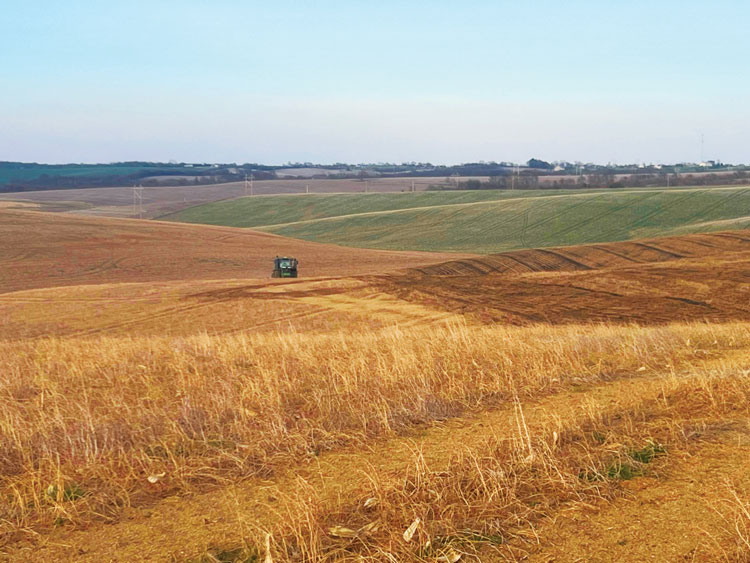The author is a nutrient management specialist and sampling director at Rock River Laboratory in Watertown, Wis.

Farming can take on many forms. In the early days, full tillage and “plowing it black” was the law of the land. Then came the early conservation tillage tools. These were designed to leave more residue on the surface and slow wind and water erosion. A further desire to cut back on tillage led growers to reduced tillage options such as vertical till or strip till. The ultimate reduced tillage can be found with no-till farming.
Today, all of these tillage options can be found on farms from coast to coast. While every grower has his or her reasons for choosing a particular tillage program, how do these styles of farming fit into the world of nutrient management?
N and P — same to me
Phosphorus is unlike nitrogen. It doesn’t start its life at the top of the soil profile and leach down and out of reach of plant roots. Phosphorus is actually quite the opposite.
Phosphorus anions form bonds with calcium, aluminum, and iron and take on a positive charge. This positive charge forms a strong bond to soil particles that nearly eliminates phosphorus leaching. Phosphorus generally leaves the field still attached to these tiny soil particles, most of which are undetectable to the human eye. If manure is present in the system, especially surface applied manure, the manure itself may leave the field and contribute to even greater phosphorus losses.
How can we overcome the issue of soil loss and phosphorus loss at the same time? That’s when the soil loss and manure application interface gets more difficult! Effective incorporation serves two very valuable purposes when it comes to nutrient management. The first should be quite apparent at this point. Putting manure below the soil surface makes it far less susceptible to field runoff loss.
The second item may be less clear. When manure is injected into the soil or incorporated promptly, you will make more efficient use of manure nitrogen. This is because manure that is buried in the soil is less susceptible to atmospheric loss through volatilization. Both of these benefits point toward injection or, at the very least, incorporating manure as soon as it’s applied.
But effective incorporation also means soil disturbance. Soil disturbance means greater risk of soil loss. Industry-wide, it seems that two management concepts are coming to the forefront to help growers avoid this higher soil loss.
The first is low disturbance application bars. These bars do everything their name implies — injecting the manure into the soil with as little soil disturbance as possible. They range from cutting small slits in the ground and knifing in manure to row units that function similar to a strip till bar.
The second practice is one that is gaining major traction throughout all of agriculture: cover crops. Cover crops can be planted before or after manure application. Armoring the soil through the use of cover crops protects against the effects of rainfall and will help keep nutrients in the field right where they belong. A cover crop may also help trap applied nutrients from leaching loss over the winter while capturing and upcycling underutilized nutrients from the previous growing season.
In my travels as a nutrient management planner and professional soil sampler, I have seen several combinations of cover crops and manure. A very common method seems to be harvesting corn silage followed by immediate chisel plowing. About a bushel of oats or rye is then no-till planted into the worked ground. This is followed by manure application with a low disturbance bar a month or two later, once the cover is up and growing well. I have also seen similar variations that broadcast the cover crop seed rather than drilling it in. This seems to have a weaker establishment, but it does help save a trip.
Timing is everything
Another practice that can fit into both manure and nonmanured systems is split application of nutrients. These are particularly important when it comes to nitrogen, as it has a propensity for loss through the bottom of the system. Through strategically timing manure applications closer to crop uptake, growers can reduce the possibility of nitrogen loss due to leaching.
All soils are different and some soils can hold more nutrients than others. Each state has a list of soil types with a high probability of nitrate leaching. Most nutrient management plan rules contain a maximum application rate for manure or fertilizer applications to these soils. Maximum fall application rates may be based on total volume or nutrient content. Some fall applications, especially commercial fertilizer, may be prohibited completely. The actual rules will vary by state.
Additional manure may be applied to these fields if the applications are split up between spring and fall seasons. A common example involves spreading a half rate of injected dairy manure in the fall, then following that up with an additional half rate of manure in the spring. This will allow for a full rate of nitrogen to be applied to a sensitive field in an environmentally sound manner.
With high input prices, more and more growers are looking to spread manure on more acres. A base rate of manure can be laid down on nonlegume ground followed by a supplemental preplant and/or sidedress application of commercial fertilizer to meet total crop nutrient demand. The split application system can be taken a step further by incorporating pre-sidedress nitrate testing (PSNT) or nitrogen models into the equation. Both of these options will help evaluate the quantity of nitrogen still available from the manure and help fine-tune additional applications.
It’s a precision decision
Technology is advancing rapidly when it comes to optimizing nutrient applications. More and more growers are pulling precision grid PSNT samples. Farmers are still incorporating nitrogen models to estimate follow-up application rates. Improved technology is booming in the sidedress application field.
On the manure application side, flow meters and near infrared reflectance spectroscopy (NIRS) are becoming more prevalent on field equipment. By combining flow meter and/or NIRS data, the exact inputs applied to each area of a field can be entered into data management software. A nitrogen recommendation can then be generated that incorporates all of the small variabilities of large-scale manure application into the recommendation.
Taking things up another level, there are hosts of remote imaging tools available to aid in estimating crop nutrient demand. These can be satellite based, airplane or drone based, or even mounted right to a sidedress application rig. There are many variations, but the general principle remains the same: capture an image of the growing crop, evaluate the need for additional nitrogen, and vary the nitrogen application rate based on the imagery.
Weaving together manure application and nutrient management can be a troublesome task at times. Balancing the risk of phosphorus loss and soil loss while still managing nitrogen leaching and volatilization can seem daunting. However, keeping an open mind, considering the farm management style, utilizing resources and tools available, and turning an eye to the future can help quell some of these challenges to optimize a nutrient strategy.
Growers shouldn’t be afraid to give new technology or even different management styles a try on a few acres. It could turn into the future strategy for the farm.









